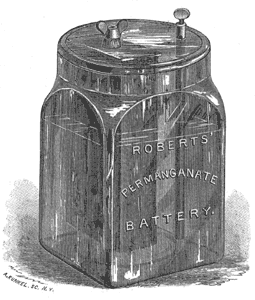[Trade Journal]
Publication: Electrical World
New York, NY, United States
vol. 6, no. 13, p. 133, col. 2
The Roberts Permanganate Battery.
For many years after the electric battery became a commercial success, attempts were made to obviate the disadvantage under which they labored, consisting in the fact that they destroyed themselves, whether they were at work or not. These closed circuit batteries, of which the many forms of Daniell and the Bunsen are examples, could not be economically applied where an electric current was used for a short time at long intervals, such as for bell-ringing and similar purposes. Although numerous efforts were early made to construct an open circuit battery, the first successful one was that of Leclanche, which consumes material only during the time that the circuit is closed. In this cell, as is well known, the active agent is sal-ammoniac, dioxide of manganese being used as the depolarizer. Numerous forms of the Leclanche cell have been constructed since the introduction of the latter, differing from it more in mechanical construction than otherwise. The makers of most of them also, while using sal-ammoniac, were obliged to abandon the dioxide of manganese, the use of which was prohibited during the life of the patent of the Leclanche cell. In all these batteries the zinc chloride formed replaces the chloride of ammonium in the solution, and the efficiency of the battery diminishes in proportion as this action takes place.
 |
| New Permanganate Battery. |
Recently, however, a decided variation in open-circuit batteries has been brought about by the use of an entirely different solution from the one heretofore almost universally employed.
The new battery shown in the accompanying engraving known as the Roberts Permanganate, has a solution which consists of a base of permanganate of potash, to which is added the salt of an alkali, such as table salt, sal-ammoniac, or the like. After many trials the solution finally adopted consists of a mixture of permanganate of potash, bichromate of potash, table-salt and sal-ammoniac.
Precisely what the chemical action in this cell is, is not definitely known. The solution is gradually destroyed, and the waste of zinc is very slight and takes place through oxidation. Many analyses have shown, however, that it is not taken into solution, as is the zinc in the sal-ammoniac cells, in which respect it differs radically from the latter. It would appear also, from the slow consumption of the zinc, that the principal action takes place between the elements of the solution, and hence a cell may be repeatedly charged with new solution without a renewal of the zinc.
The electrical constants of the battery show it to be very favorable of economic application. Its electromotive force averages 1.8 volts and it has an internal resistance of about 7 ohms, thus giving a current of about 2.5 amperes on short circuit. A small but important detail of construction also deserves description, consisting in the method adopted for making a good contact between the line and the carbon. For this purpose the latter has a hole drilled in the top, into which is inserted a brass pin of smaller diameter. The remaining space is then filled with a metal which expands upon cooling and hence makes a perfect connection between the carbon and the threaded pin to which the line is attached.
